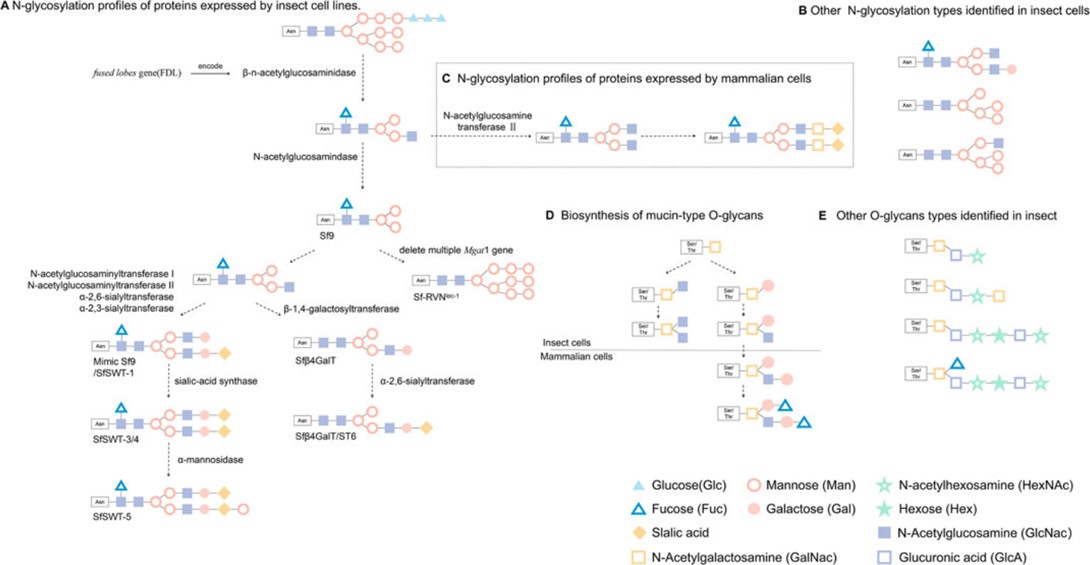Insect Cell Glycoengineering Services
Why Glycoengineering in Insect Cell?
Insect expression systems, combined with baculovirus expression vector systems, have gained widespread popularity for recombinant protein production due to their cost-effectiveness and high yield for secreted protein. Insect cells possess the capacity for posttranslational modifications including both N- and O-glycan processing as mammalian cells. This capability makes insect cells attractive as expression hosts for producing recombinant glycoproteins. However, the endogenous glycan processing pathways in insects are less extensive than in mammalian cells, such as insect cells typically produce simpler and truncated paucimannose N-glycans and lack the ability to perform terminal sialylation. Glycoengineering in insect cells, such as the introduction of humanized glycosylation pathways, enables the production of recombinant glycoproteins featuring human-type or customized glycans.
 Fig.1 Glycoengineering in insect-based expression systems.1, 3
Fig.1 Glycoengineering in insect-based expression systems.1, 3
Insect Cell Glycoengineering Services at Creative Biolabs
With years of experience in Glycoengineering Services, Creative Biolabs has been at the forefront of efforts to address the challenges associated with glycosylation in insect expression systems. We offer comprehensive services in insect-based glycoengineering, which primarily involve eliminating insect-specific pathogenic glycans and introducing mammalian glycosylation capabilities into insect cells. Additionally, the insect-baculovirus cell system is a binary system consisting of two different platforms. Creative Biolabs provides glycoengineering services not only in insect cells but also in baculovirus expression vectors, based on various strategies. These services are designed to facilitate the high-yield production of humanized proteins with customized glycosylation profiles.
Strategies of Glycoengineering in Insect-baculovirus Expression System
-
Glycoengineering in insect cell
Efficient knockout of genes responsible for pathogenic glycan structures.
High-level expression of mammalian glycosyltransferases as well as the target protein.
-
Glycoengineering in baculovirus expression vector
Expression of mammalian glycosyltransferases.
Expression of the target protein.
-
Co-infection of baculoviruses encoding mammalian glycosyltransferases and the target protein.
-
Single-infection of the baculovirus encoding glycosyltransferases and the target protein simultaneously.
Techniques for Insect Cell Glycoengineering
Creative Biolabs has developed powerful tools and methods for glycoengineering in insect-based expression systems. These methods encompass Gene Silencing through RNA interference (RNAi), complete gene suppression via stable gene knockout, and achieving high-level gene Overexpression. Our repertoire of Precise Genome Editing tools has been effectively employed for site-specific modifications. These tools have the capability to facilitate not just gene insertions but also deletions and mutations.
Equipped with these cutting-edge techniques, Creative Biolabs is confident in providing high-quality glycoengineering services, particularly in N-linked Glycoengineering in Insect Cell. It's worth noting that although N-linked glycosylation has been extensively engineered in insect cells, O-linked glycoengineering in insect cells is still an area that requires further exploration and development.
Features of Our Services
-
Optional glycoengineering strategies for both baculovirus and insect host.
-
Cutting-edge techniques for gene regulation and precise genome editing
-
High-level gene expression and high-yield glycoprotein production
-
Customized glycoengineering for tailored glycan patterns
Published data
Traditional insect cell lines face two major challenges in the production of recombinant proteins. First, the N-glycosylation structure produced by insect cells is relatively simple, mainly mannose, and cannot be compared with the complex sialylated N-glycans produced by mammalian cells, which may affect the stability and biological activity of recombinant proteins. Secondly, cell lysis caused by baculovirus infection increases protease activity, thereby compromising the quality and yield of recombinant proteins. To this end, researchers have developed improved insect cell lines, which have improved their post-translational modification (PTM) capabilities by integrating glycosyltransferases and utilizing technologies such as CRISPR-Cas9, making the glycosylation level of recombinant proteins closer to that of mammalian cells, bringing new opportunities for their application in biopharmaceuticals.
 Fig.2 Glycosylation types in insect cells.2, 3
Fig.2 Glycosylation types in insect cells.2, 3
Drawing on our wealth of experience and cutting-edge technologies, Creative Biolabs is delighted to offer a comprehensive selection of glycoengineering services customized for insect cells. We encourage you to contact us for additional information. Our team of expert scientists is standing by to address any specific requests or questions you may have.
References
-
Kightlinger, Weston, et al. "Synthetic glycobiology: parts, systems, and applications." ACS Synthetic Biology 9.7 (2020): 1534-1562.
-
Hong, Minqing, et al. "Genetic engineering of baculovirus-insect cell system to improve protein production." Frontiers in Bioengineering and Biotechnology 10 (2022): 994743.
-
Distributed under Open Access license CC BY 4.0, without modification.
For Research Use Only.
Related Services

 Fig.1 Glycoengineering in insect-based expression systems.1, 3
Fig.1 Glycoengineering in insect-based expression systems.1, 3
 Fig.2 Glycosylation types in insect cells.2, 3
Fig.2 Glycosylation types in insect cells.2, 3



